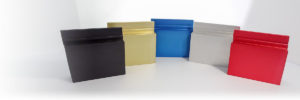
© 2025 AMF Technologies, Inc. All rights reserved.
By visiting our site, you agree to our privacy policy regarding cookies, tracking statistics, etc.
Close tolerance and selective finishing are two of our specialties. Whether the work is Military specification or a customer driven specification, we handle the job expertly, professionally and to the quality standard you demand-from start to finish.
Passivation is a method of stainless steel and titanium finishing that allows the material to become less affected by environmental factors. It is one of several processes that can bring out the metals’ inherent corrosion resistance properties, which is essential for machined stainless steel and titanium parts and components.
As a non-electrolytic finishing process, passivation uses nitric or citric acid to remove free iron from the surface. The passivation process chemically removes free irons and adds a thin oxide film layer. Less iron at the surface means more chromium and a thicker chromium oxide surface when the stainless steel is exposed to the environment. The result is a passive, protective oxide layer that is less likely to react with oxygen to initiate corrosion.
Electropolishing provides smoother and more reflective metal surfaces that reduce product adhesion and enhance cleanability. The process dissolves free iron, inclusions and embedded particles that improves corrosion resistance, durability and performance.
Based on the principle of electrolysis, electropolishing uses a flow of current, a solution of sulphuric and orthophosphoric acids as an electrolyte. It is a relatively quick procedure that can range between two minutes and twenty minutes, depending on the size and shape of the product. Bypassing a direct electric current to the product and submerging it into the electrolyte, results in the removal of metal irons, a highly Passive and an enriched Chromium Oxide surface.
Stainless Steel Finishes
The oxide layer of stainless steel prevents oxygen from reaching the iron within the material, which would otherwise lead to rust and deterioration. During the fabrication process, oils or grease contaminate the protective natural oxide layer.
With passivation, we remove contaminants and free iron from the surface by cleaning the metal with both alkaline and specified acid. Slowly and naturally, a “passive” layer develops on the surface and it is once again unreactive to environmental elements. This passive layer is not visible, but it acts as a barrier that prevents oxygen and moisture from reaching the iron underneath.
An alternative to passivation for corrosion resistance, electropolishing stainless steel products can provide some additional benefits. Electropolishing can remove surface imperfections and embedded debris for increased corrosion resistance, provide a bright metal finish for a natural shine and improve surface adhesion as a preparation for other finishing processes.
Titanium Finishes
Due to its excellent corrosion resistance and lightweight, titanium makes it an excellent material for aerospace components, chemical processing equipment, marine applications, medical implants and more. Contaminants and oxides can affect the surface of titanium parts if they are not removed. Passivating titanium removes iron and other contaminants from the surface. The passivation process does not remove particulates that may become embedded in the material. Electropolishing provides the advantage of eliminating embedded particulates, restoring corrosion resistance, and brightening the appearance if that is desired.
© 2025 AMF Technologies, Inc. All rights reserved.